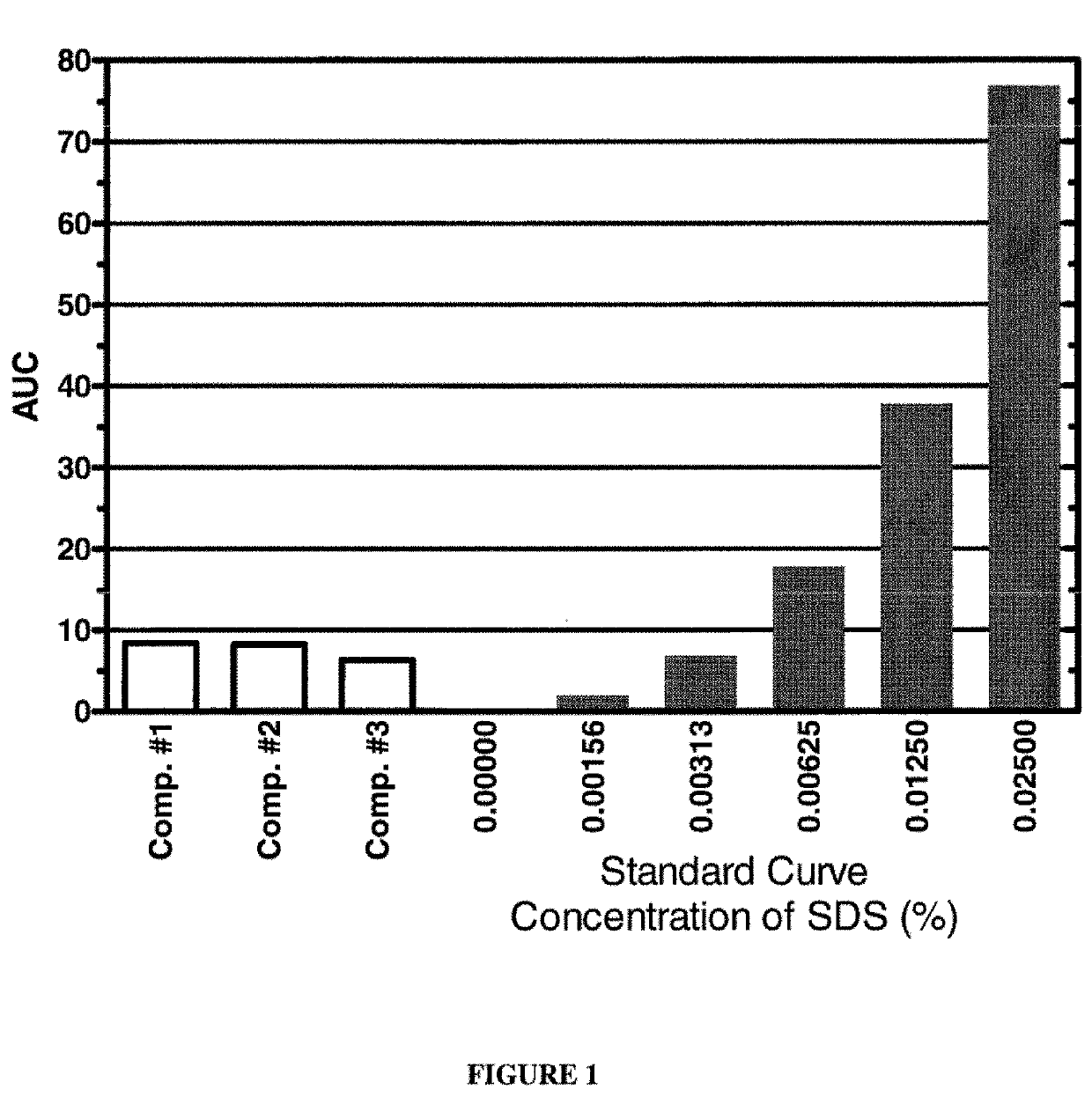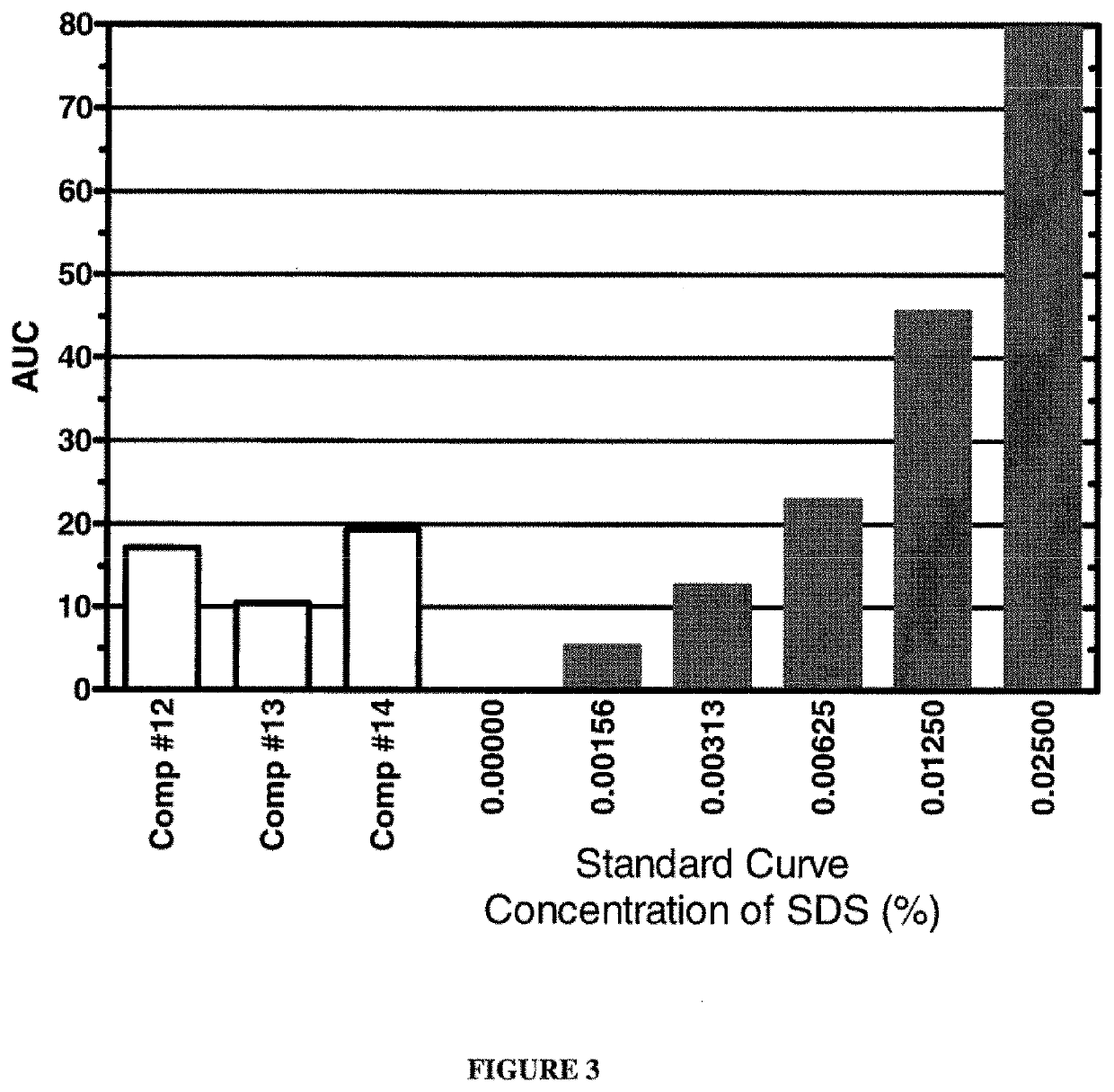A composition, system and method for removal of detergents from aqueous solutions
a technology of aqueous solution and detergent, applied in the field of composition, system, method and kit for removing detergent from an aqueous solution, can solve the problems of inactivation of most enzymes, including nucleases, undesired effects, and inhibitory reagents used in these procedures
- Summary
- Abstract
- Description
- Claims
- Application Information
AI Technical Summary
Benefits of technology
Problems solved by technology
Method used
Image
Examples
example 1
Assay System for Detecting Low Concentrations of SDS
[0074]A sensitive assay system was developed to quantify very small (<0.01% wt / vol) amounts of SDS in samples. The quantification of SDS in this assay is based on the use of the 3,3′-diethyl-9-methyl-4,5,4′,5′-dibenzothiacarbocyanine dye, also known as Stains-All. This is a fuchsia dye that turns yellow in the presence of SDS. The assay allows for the accurate detection and quantification of as little as 0.003% SDS in a sample.
[0075]The assay was adapted from the one described by Rusconi et al. in “Quantification of Sodium Dodecyl Sulfate in Microliter-Volume Biochemical Samples by Visible Light Spectroscopy.”Analytical Biochemistry. 2001. 295, 31-37.
[0076]Equipment
[0077]Tecan Infinite 200 Plate Reader
[0078]Grenier 96 well Flat Bottom Transparent Polystyrol Plate
[0079]Reagents
[0080]Stains-All [Sigma-Aldrich, Cat. No. E9379-1G]
[0081]Isopropanol [EMD, Cat. No. PX1834-6]
[0082]DMSO [BDH, Cat. No. B10323]
[0083]10% SDS (w / v) [EMD. Cat. N...
example 2
n of Detergent Removal Compositions
[0104]Various detergent removal compositions of the present invention were used to remove SDS from aqueous solutions containing known amounts of SDS. One hundred microlitre aliquots of the aqueous compositions containing different concentrations of SDS were prepared. SDS removal was carried out by adding a salt and 20 μl of a 1:1 (vol / vol) mixture of a higher alcohol and halocarbon as described below. The tubes were vortexed vigorously for 2 minutes and centrifuged at 13,000 rpm for 2 minutes. The top (aqueous) phase was removed and residual SDS in the aqueous phase was quantified using the modified Stains-All Assay described in Example 1. The results are shown in FIGS. 1 to 3. The dark bars represent the SDS standard solutions, whereas white bars represent results from the tested detergent removal compositions.
[0105]The graph shown in FIG. 1 depicts the results of an experiment in which an aqueous solution comprising 1% SDS was treated with variou...
example 3
f SDS from a Saliva-Containing Sample
[0108]To demonstrate the effectiveness of the present invention in an aqueous composition containing a biological sample, a fresh human saliva sample was collected in a 15 ml conical tube. One milliliter of saliva was treated with an equal volume of lysis buffer containing 4% SDS and 250 mM LiCl and digested with Proteinase K (“PK”) at 60° C. for 15 minutes. PK was inactivated by heating at 90° C. for 15 minutes and a 93.75 μl aliquot of the treated saliva in lysis buffer was mixed with 6.25 μl of a 2 M ammonium chloride solution.
[0109]Detergent removal was carried out by adding 20 μl of a 1:1 mixture of 1-pentanol and BDCM to 100 μl of the treated saliva sample. The tube was vortexed vigorously for 2 minutes and centrifuged at 13,000 rpm for 2 minutes. The top (aqueous) phase was removed and SDS was quantified using the modified Stains-All Assay described in Example 1. The results are shown in FIG. 4. These results demonstrate the successful rem...
PUM
| Property | Measurement | Unit |
|---|---|---|
| miscible | aaaaa | aaaaa |
| aqueous | aaaaa | aaaaa |
| lipophilic | aaaaa | aaaaa |
Abstract
Description
Claims
Application Information
 Login to View More
Login to View More - R&D
- Intellectual Property
- Life Sciences
- Materials
- Tech Scout
- Unparalleled Data Quality
- Higher Quality Content
- 60% Fewer Hallucinations
Browse by: Latest US Patents, China's latest patents, Technical Efficacy Thesaurus, Application Domain, Technology Topic, Popular Technical Reports.
© 2025 PatSnap. All rights reserved.Legal|Privacy policy|Modern Slavery Act Transparency Statement|Sitemap|About US| Contact US: help@patsnap.com



